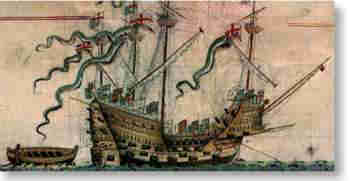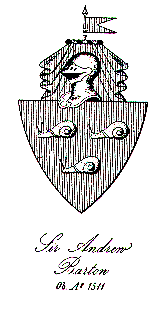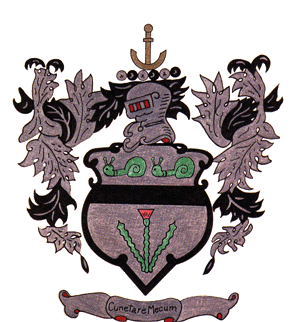Most of the material on this page is derived from material in the Joseph Earle Steadman book and from Jean Christie who resides in Scotland. She graciously shared some of her materials with Wayne Hendon who, in turn, has shared them with me. Thank you Joseph, Jean, and Wayne!
by Joseph Earle Steadman (pp.9-13)
The lineage shown in this page was documented in the so-called Barton-Stedman Menoir by John Stedman of Bath, County Somerset, England, and privately printed in 1857. The lineage was authentically proved and passed inspection by the British College of Arms.
Stedman states that "barton" is a Saxon word, and the subject of the family "doubtless assumed its name from a village near old Walton in the West Riding of Yorkshire, England, where they were probably located before or at the period of the Norman conquest." Though the Domesday Book mentions no person of the name "Barton" living in that locality, the family soon emerged from obscurity and took rank among the magnates of the land. A supposed branch of this family existed in the old French provinces of Bretagne (Brittany) and Normandy, where they were known as "de Barton" and bore the same arms:
-
"Gules, annulets Or", meaning "a shield of red color with
small rings of gold color depicted thereon".
The following lineage shows only the line of descent from Radulphus (Ralph) de Barton, the first known ancestor, to Alexander Barton, who became Charles Stedman.
1. Radulphus de Barton ( ? - after 1154)
-
Radulphus de Barton was living in County York, England during the reign of King Henry II (1154-1189).
-
Thomas Barton was the younger of two sons. He was of Ainderby and Kirklington in County York. Between the
6th and 12th years of King John (1199-1216) he made a grant of land to the monks of Fontaines, whose
celebrated abbey was situated at Rieval (or Riveaux) near Helmsley, in County York. The abbey was about
twelve miles northeast of Ainderby. Thomas married Cecily _____ about 1195. They had two sons. She survived him.
-
Sir William Barton, Knight, was the younger son of Thomas and Cecily Barton and resided at Steresby,
County York, England. He was seized in those lands in 1236. He had three sons and a daughter.
-
Sir John Barton, the second son of Sir William Barton, was of Fryton and Steresby in County York and was
seized in those lands in 1310. In 1299, King Edward I (1272-1307) granted him by charter roll "free
warren, etc., in all his demesnes of Fryton, Holthorp, etc., in County York." The Roll of
Arms shows that during the time of King Henry III (1216-1272) his armorial bearings were recorded:
"Monsire de Barton port d'ermin, sur les fess gules, trois annulets d'or."
He had three sons and died after 1310 in County York, England.
-
Robert Barton was the youngest son of Sir John Barton. In 1315, Robert was the receiver and keeper
of military stores in the District of Carlisle, County Cumberland, England. He married Margaret _____ and
had two sons and a daughter.
-
Robert Barton was the youngest son of Sir John Barton. In 1315, Robert was the receiver and keeper
of military stores in the District of Carlisle, County Cumberland, England. He married Margaret _____ and
had two sons and a daughter.
-
John Barton was the older son of Robert and Margaret Barton. John appears to have been in the confidence
of King Edward III (1327-1377). He was a Burgess of Kingston on Hull River in County York, and, in 1334,
he was collector of customs there. He also held various commissions for the defense of the kingdom
between that period and 1338. He had two sons.
-
Philip Baron was the older son of John Barton. In 1346, he was chancellor of Berwick on Tweed River in
County Northumberland, England, where he died in 1347. He had one son and a daughter.
-
Robert Barton was the son of Philip Barton. He was the Master of the Hospital at Saint Mary Magdalene at
Berwick on Tweed River in County Northumberland, England, where he was living in 1344. He married
Margaret _____ and had two sons.
-
William Barton was the older son of Robert and Margaret Barton. In 1425, he was collector of customs at
Kinghorne, County Fife, Scotland. (Chalmers in his History of Dunfermline, Scotland states that
the County York Bartons came to Scotland after a contest with King Edward III. He had one son.
-
Andrew Barton was the only son of William Barton. He was living at Leith, County Edinburgh, Scotland during
the reigns of King James III (1460-1488) and King James IV (1488-1513). In 1505, he was distinguished
from his grandson "Andrew Barton the younger". According to Item 3041 in The Register of the
Privy Seal of Scotland, Vol. I (A. D. 1488 -1529), he married Margaret Prestoun. Andrew died before
June 22, 1518 and left three sons.
-
John Barton was the eldest son of Andrew and Margaret (Prestoun) Barton and born about 1440 at
Leith, County Edinburgh, Scotland and was murdered while being held prisoner in 1476.
During the reign of King James III (1460-1488), Captain John Barton was a celebrated Scotch naval officer and a merchant shipper of Leith, County Edinburgh, Scotland. He is mentioned in the 1474-1475 account of the Chamberlain of County Fife, Scotland, as master of the vessel "King's Carvel" (or the "Yellow Carvel"), which was plundered by the Portuguese.
In 1476, he put out to sea from the Port of Sluys/Sluis (in Flanders - now part of Zeeland, Netherlands) with his ship "Juliana." The ship (laden with a very valuable cargo) was suddenly attacked by two armed Portuguese ships, one of which was commanded by Juan Vasques and the other by Juan Pret. Some of the crew of the Juliana were killed, many wounded and forced into slavery, while others were thrown into a fishing boat and set adrift, and the Juliana was carried in Lisbon, Portugal. It appears that John was among those who were set adrift. He proceeded to Lisbon to seek indemnity, and the affair was brought before the court of law. The court trifled with or evaded the matter, and as John persisted in pursuit of redress, he was murdered, with a view of putting an end to the affair.

-
At some point during the period of 1460 to 1476, King James III gave to John Barton the gift of mariage
(tenure of land and buildings, including a dwelling house). After John's death, the King gave the mariage to
M. James Henrisoun (The Register of the Privy Seal of Scotland, Vol. I (A. D. 1488 - 1529), Item 3041).
John was the father of three sons and a daughter.
-
Andrew Barton was the eldest son of John Barton and was born about 1466 and was of Leith, County
Edinburgh, Scotland. Like his grandfather, he was a famous Scottish naval officer. In August, 1511, Admiral
Barton was killed during a great naval battle with the English.
The following was said of him by some authors:
-
(a) Andrew Barton: One of Scotland's first great naval commanders; flourished during the reign of
James IV, and belonged to a family which for two generations had produced able and successful seamen.
(The American International Encyclopedia, Vol. II)
(b) The real founders of the Scotch navy were the two Barton brothers; Andrew and Robert, and others of their time. (J.H. Campbell Irons, Leith and its Antiquities, Vol. 1 and II.)
(c) The Bartons (Andrew, Robert, and John), like their shipmate and friend, Sir Andrew Wood, all obtained high honor and fame, though their origin was more distinguished than his, and they were long remembered among the fighting captains of Leith. The eldest brother, Andrew Barton, was an especial favorite of James IV who bestowed upon him the then coveted honor of Knighthood for "upholding the Scottish flag upon the seas". (Grant-Cassell's Old and New Edinburgh, Vol. III) Thereafter, he was known as Admiral Sir Andrew Barton.
In 1497, Admiral Sir Andrew Barton furnished provisions for the "Lion" (a celebrated ship jointly owned by the Barton brothers), commanded by his brother Sir Robert Barton on the occasion of conveying Perkin Warbeck and his wife (styled the Duke and Duchess of York ) from the port of Ayr, in Scotland, to the continent. Perkin Warbeck was a pretender to the throne of England, and was hanged in 1499.
In the summer of 1506, James IV appointed Admiral Sir Andrew to the command of a large, costly, and newly-built ship, and ordered him to avenge a flagrant act of injustice and cruelty committed by the people of Holland. The Hollanders had seized some Scottish ships and thrown the merchants and mariners into the sea. Sir Andrew retaliated by taking several of the Hollanders' ships, sent to Scotland several barrels filled with the heads of the offenders, and returned himself with much booty and renown. (The writer of the Barton-Stedman Memoir excuses this bloody and barbarous act of Sir Andrew as being not unusual for that rough and turbulent time.)
Immediately after the seizure of John Barton's ship and the mistreatment of its crew, King James III complained by letter to the King of Portugal about the affair of 1476, and claimed compensation for the sons of John Barton. Minor satisfaction resulted from the complaint, and James III later decreed letters of marque (reprisal) against the Portuguese. However, in hope of redress by the Portuguese, the letters were being held in abeyance when the king died in 1488. James IV, his son and successor, then was an infant and the letters lay dormant until 1494. In that year, James IV granted new letters to the two younger sons (Robert and John, Jr.) of John Barton.
These letters also were held in abeyance until renewed in 1505, authorizing the three sons (now including Sir Andrew) "to make reprisals on the Portuguese to an amount equal as the goods of which they had been plundered, and of which restitution was denied; and that wheresoever Andrew, or his brothers, or their assigns, should meet with or could seize any one or more Portuguese (ships), by sea or land, it should be lawful for then to do so, to the utmost of their power, forever, until satisfaction should be made, to an equal amount for the loss of the ship, and the destruction and plunder of all the goods which were on board and for the slaughter of the seaman and kinsmen of Andrew, and his brothers, to the number of seven men."
In order to give these letters all possible publicity, James IV wrote to "all Kings, Princes, Potentates, and States on the Coast, to notify them that the Bartons, and their ships, were not to be deemed pirates, but such as had true letters of marque and reprisal from him." In 1563, all letters of marque granted to the three brothers and their successors were formally recalled by Mary Stuart, Queen of Scots (1542-1567).
In 1508, Admiral Sir Andrew Barton was sent by the King of Scotland to assist Denmark in war against the Hanseatic town of Lubeck in Germany. (Dictionary of National Biography)
From Item 2175 in The Register of the Privy Seal of Scotland, Vol. I (1488-1529), it is learned that, in recognition of his deeds, on 2 January 1510, King James IV gave to Admiral Sir Andrew and his heirs the grant of an escheated estate consisting of the domicile and all lands of Ballinbreich, and the grant of advowson to the Chapel of Glenduky located on the said estate. The grant of advowson made Sir Andrew and his heirs responsible as patrons of the chapel, with the right to nominate someone as clergyman to serve the chapel. As part of their responsibility the patrons furnished a "church living" for the clergyman. On 16 October 1510, Ballinbreich was merged into the estate of Hall-Tacis (see below).
Item 3511 of The Register of the Great Seal of Scotland, (1424-1513), shows that on 16 October 1510, at Edinburgh, King James IV granted to Andrew Barton and his son Alexander Barton the freehold estate of Hall-Tacis. This estate, created specifically for them, was formed by merging together the whole or parts of the lands of Tacis (including Hall-Tacis and Hill-Tacis), Ballinderaine, Heighame, Logy, Ballinbreich, Leslie, and Ballingall. The newly formed estate was situated partly in county Kinross and partly in County Fife. In 1557 Mary Stuart, Queen of Scots, confirmed "letters made by Alexander Barton selling the estate to John Pattersoun."
Under the letters of marque granted to them in 1505, the Barton brothers put out to sea in merchant vessels of the largest type of those days. These vessels had low waists and very high poops and forecastles. Sir Andrew pursued his course with such vigor and success that even his name was a terror to the Portuguese. They were driven to the expedient of sending their goods to England in English ships, but this ruse did not defeat Sir Andrew in his purpose. He did not hesitate to attack such ships and seize the Portuguese goods found on board.
The English merchants complained to the Kings Privy Council, who coldly received and rejected their complaint since Sir Andrew's acts were lawful under the authority granted by letters of marque. The Portuguese merchants likewise complained to their King who, on the plea of friendly alliance, demanded King Henry VIII of England to "clear the seas of Sir Andrew." Moved by such incitement, Lord Thomas Howard obtained permission of the English king to fit out two ships for the purpose. Lord Thomas and his brother Sir Edward Howard were appointed to command the ships.
After having equipped three ships of war and an armed collier, the Howard brothers sailed from the Thames River in search of Sir Andrew Barton. They met him in the English Downs (a roadstead in the North Sea, along the coast of County Kent, England) as he was returning from a cruise on the coast of Portugal. Sir Andrew had with him only two of his ships, the "Lion" (of 36 guns, and commanded by himself) and the "Jenny Pirwine" (an armed collier). [Another ship owned by him was the "Cuckoo" (Grant-Cassell's Old and New Edinburgh, Vol. III; Dictionary of National Biography)]
This meeting occurred on August 2, 1511, and immediately resulted in a long and bitterly fought conflict in which Sir Andrew was wounded. Even so, he continued to encourage his crew until he received a cannon ball in his body and fell dead upon the deck. His ships were immediately boarded and carried into the Thames River. After a short imprisonment the crews were dismissed, but the ships were retained as prizes.
The "Lion" was placed in the English navy as the second ship of war. This conflict between Sir Andrew and the Howard brothers is commemorated by English poets, from their point of view, in "The Ballad of Sir Andrew Barton" (included in Percy's Reliques of Ancient English Poetry) and in "Sir Andrew Barton" (included in Naval Songs and Ballads).
The conflict eventually led to the Battle of Flodden Field, which was fought in February 1514 between the armies of James IV of Scotland and Henry VIII of England. Though these two kings were brothers-in-law they held intense hatred and contempt for each other.
He left one son.
Admiral Sir Andrew Barton bore arms:
"Gules three shell snails Or."
Coat of Arms
(1511)

Source: Nisbet's Heraldry, edited under the patronage of Parliment, 1704
-
Alexander Barton was the only son of Admiral Sir Andrew Barton. Alexander and many of his descendants married
young and lived long lives. About 1509, he married Susan Stedman (who died in 1565) an heiress, daughter of
Charles and Janet (Neilson) Stedman of Leith.
-
Following his marriage, he changed his arms (Gules three shell snails Or) to
Argent two snails in chief Azure, and to this he joined his wife's arms: A bunch of three holly leaves
Vert in base. (Burke, The General Armory, pp 54, 667; Rietstap, Armorial General, Vol. V;
Stoddart, Scottish Arms, 1370-1678; Kings' and Nobility's Arms, Vol. I). The joined arms
(arms of alliance) denoted the alliance which Alexander and Susan had contracted by marriage. Arms of
this character are to be borne in an "escutcheon of pretense" by those who have married
heiresses, but the separate escutcheon is not allowed until the death of the father of the lady. (Burke,
The General Armory, p. XI)
When Susan's father died, Alexander added a fess, instead of an escutcheon, to the shield for distinction between Barton and Stedman.
He and his father were granted in 1510 the freehold estate of Hall-Tacis. Alexander sold this in 1557.
About 1540, during the reign of King James V (1513-1542) of Scotland, he was appointed Burgess of Edinburgh for life, Deputy Collector of Edinburgh, and Searcher of Merchandise on the shore of Leith. His son John Barton was given similar appointment with and succeeding his father (The Register of the Privy Seal of Scotland, Vol. II, A. D. 1529-1542).
On the death of Susan (Stedman) Barton in 1565, Alexander applied to Queen Mary (1542-1567) of Scotland and was granted "arms of adoption" by which he was empowered to obtain the estate bequeathed to his wife by her father, on the condition that he assume the name and arms of the deceased father. (Burke, The General Armory, p. XI) Alexander Barton thus became "Charles Stedman."
-
The arms which he assumed were: Argent. In chief two snails erect and
issuing from their shells, Purpure and Azure. In base a sprig of three leaves of sea-holly thistle (tip
of thistle bloom Purpure). A fess between the snails and sea-holly thistle. (Old Manuscript of
Blazons, of Workman's MS, in Lord Lyons Office, Edinburgh, Scotland.)

Contact: John Lisle
Copyright © 1998-2004, John B. Lisle, TQSI Consulting Group, Nashua, New Hampshire